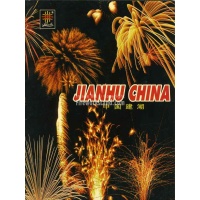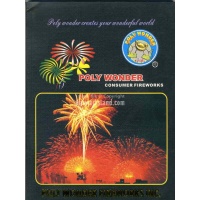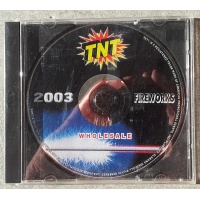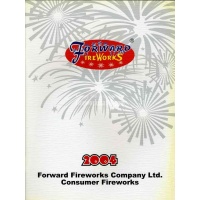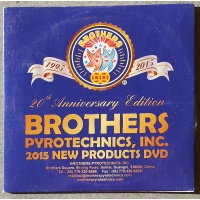Informally, fireworks can be classified into three general types: ground-level, aerial, or proximate fireworks. "Proximate" includes items such as special effects used by professionals in concerts and stage shows. The legal classification of an item is usually defined by its construction details such as size or pyrotechnic contents, chemicals used, and so forth. For a discussion of legal classifications, see this page.
There is also a glossary of fireworks-related terms at the APA's web site.
Please note that all descriptions and images below are Copyright © Bob Weaver.
| Ground-based Fireworks | ||
| Type | Image | Description |
| Chaser | Moves around randomly on ground, often whistling. Rarely sold any more | |
| Cone | Type of fountain in a cone shape. Spray of sparks typically gets taller and stronger as it continues | |
| Crackling item | Emits a burst of crackle on the ground | |
| Firecracker | Paper cylinder with pyrotechnic composition, explodes when lit. Sold individually or strung together on strings in "packs" | |
| Salute | A large ground-based firecracker. Illegal in the United States if the powder content is more than 50 milligrams. | |
| Wheel |  |
A spinning firework that is fixed to a support such as a post or stand |
| Saxon | A type of wheel that is cylindrical and rotates around its center | |
| Novelty firework | A ground firework that is constructed to look like an animal, vehicle or other non-firework object. When lit it gives some kind of pyrotechnic performance, for example emitting sparks, opening up, or moving around on the ground | |
| Snake | A pellet of pyrotechnic composition which emits an ash in the general shape of a snake | |
| Smoke |  |
A device which emits smoke, usually in a color, and can be in the form of a smoke ball, cartridge or other design |
| Strobe | A ground device which emits a series of bright flashing lights | |
| Fountain | A firework which sits on the ground and sprays displays of color sparks, whistles, crackle or other effects | |
| Ground spinner | |
A spinning firework that performs on the ground only, often moving in random directions |
| Sparkler |  |
A common firework item which is a stick coated with pyrotechnic material, which gives off sparks or other effects while it burns, and is designed to be held in hand by the user |
| California Candle | A common firework item which is a fountain in a long cylindrical tube, which gives off sparks or other effects while it burns, and is designed to be held in hand by the user | |
| Torch or Flare | A common firework item which emits a colored flame, and is designed to be held in hand by the user or laid on the ground | |
| Aerial Fireworks | ||
| Type | Image | Description |
| Cake or Repeater |
|
A multi-shot aerial firework, in one package, and fused internally so that the user needs to light only one external fuse, and the effects fire in sequence. There are different shapes, sizes and styles of cakes. See this page for a discussion of "200-gram cakes" vs. "500-gram cakes." The name "cake" got started because some of the earlier cakes were round in the shape of an actual cake. "Cake," "repeater" and "multi-shot" all mean the same thing |
| Missile battery | A type of cake, consisting of many small missiles fused together inside. They do not have fins though. A missile battery is a specialized type of repeater | |
| Shell |  |
An aerial firework, which when launched from a mortar, flies up and produces an effect in the air, while the mortar remains on the ground |
| Mortar | The tube that is used to launch a shell from. The mortar stays on the ground. Sometimes people mistakenly say "mortar" when they actually mean the shell. The mortar is the tube, and the shell is what you load into the mortar. | |
| Reloadable |  |
A boxed kit which cotains one or more mortars, and any number of shells to launch from those mortars. A kit must have at least one mortar; larger kits often have two or more. The number of shells in a kit varies, but is commonly in a multiple of 6, such as 6, 12, 18 or 24. Those are the most common, but there are kits with other numbers; some are huge kits withseveral mortars and many shells. |
| Parachute | A specific type of shell whose effect is to eject a parachute in the sky, usually from which dangles another effect | |
| Mine | A specialized aerial effect which is typically a blast of stars or other effects starting from the top of the mortar tube upward. There is no shell that flies up into the air; instead the effects are ignited at the ground level and fly upward as they burn | |
| Comet | A specialized aerial effect where a projectile is launched from a mortar and emits sparks continuously as it flies upward. The comet can be by itself, or some shells can have comets built into them | |
| Roman Candle | |
An aerial firework consisting of a single tube with multiple "shots" that fire in sequence |
| Bottle rocket | A small version of a skyrocket, typically sold in bundles of 144 pieces | |
| Skyrocket | An aerial firework which typically has a cylinder, a nose cone and a long stick. The entire device leaves the ground, and emits some effect in the air. The stick helps guide the rocket and prevents it from tumbling end-over-end as it flies | |
| Missile | |
A rocket-shaped firework with fins on the bottom, that flies up when lit. This is different from a skyrocket, which does not have fins and has a stick to stabilize it. Some missiles, such as Warhead Launcher, do not have fins and are spin-stabilized |
| Flying spinner |  |
An aerial firework that flies upward as it spins. The upward motion is produced either by the addition of wings, or by an additional pyrotechnic tube providing downward thrust. These are sometimes called "helicopters" or rarely "tourbillions" |
| Proximate Fireworks | ||
| Ice fountain | A common indoor firework, typically used on a cake or other indoor specialized use | |
| Gerb | A type of fountain device used in professional stage shows, which gives off a spray of sparks | |
| Lance | A small color flare, used for set pieces | |
| Set piece | A type of fireworks display where many small colored flares (lances) are arranged on a framework to form a picture of something, and usually all the flares are lit at once, so that the audience sees the picture defined by the colored flames. This could depict a flag, a patriotic symbol such as the Liberty Bell or Statue of Liberty, a famous person, a company name or logo, or any other illustration that can be constructed. | |
| Niagara Falls | A type of fireworks display where a row of gerbs or fountains hangs down from a supporting structure, and emit white sparks downward, forming a white curtain of sparks. | |
| Proximate pyrotechnics | A large class of special effect pyrotechnics, used in concerts, stage shows, theatrical presentations, television and movie productions. In addition to gerbs, lances and set pieces, other effects include airbursts, comets, mines, concussion mortars, waterfalls or "Niagara Falls" effects, flash pots, flame projectors, rockets that travel along wires, and custom-built devices and effects. All of these are strictly professional pyrotechnics and require licences and permits. | |



